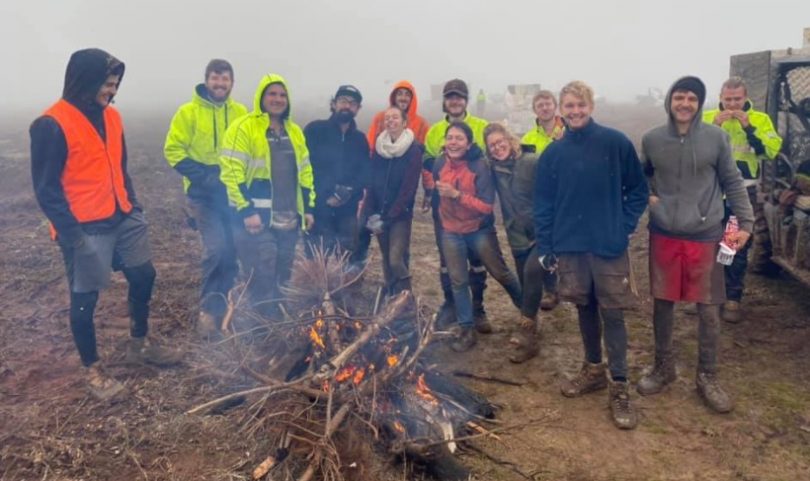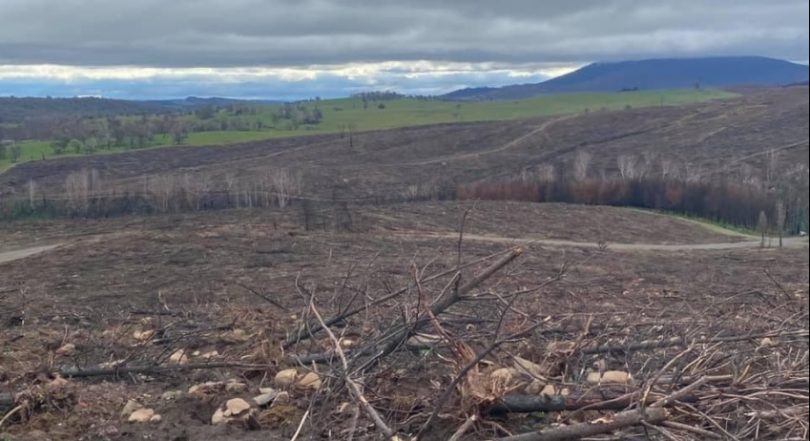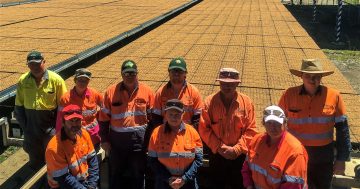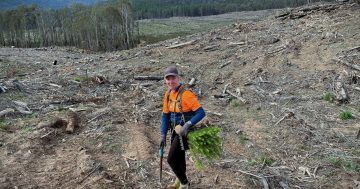
Rugged up and ready to go, crews hand plant each pine seedling in the Snowy Mountains five days a week throughout winter. Photo: MKS Forestry Contracting.
If you’re lamenting the loss of forests to bushfires in recent years, spare a thought for Matt Stone from MKS Forestry Contracting, who has 7.5 million cypress pines to plant during the next three years.
The fact the prime tree planting time east and west of the Snowy Mountains is winter, makes the task more onerous because he lacks a significant workforce to help.
Usually Matt and his brother would have a team of 40 each working out of Bombala and Tumbarumba, but the ongoing COVID-19 pandemic means numbers of Working Holiday Maker (WHM) workers are significantly reduced.
In March 2021, he secured 20 workers, but as he turned his attention to supplement the team with local labour, he was hitting brick walls.

The bushfire damaged forests of the Snowy Mountains are being prepared for planting, with seedlings to be harvested in 30 years’ time. Photo: MKS Forestry Contracting.
“It’s a bit hard when the government doesn’t support the retention of backpackers and pays Australians not to work,” he says.
But this is a fourth generation of forestry workers and not much gets in their way.
In an industry that is largely machine driven, the actual planting of trees is still done manually, with teams lining the slopes of the Snowy Mountains, and individuals lugging two heavy crossbody bags and a small 25cm shovel to dig the holes.
This is where Matt cut his teeth, at age 17 in the days when the workforce was primarily local.
Today, he handles the contracts for Forestry Corporation NSW. Matt and his brother are among 10 contractors trying to repopulate the devastated mountains with trees.
“When I used to work for a contractor 14 years ago, I wouldn’t know what a backpacker was in our workforce,” says Matt. “We had all Australians and these were people who would travel from the coast, Canberra, from all over the place to plant trees during winter.
“Now they’re making it too easy for Australians to stay at home and do nothing.”
A normal year in their schedule would see around 1.5 million trees, or 800 hectares of mountainside, planted out from June to August. But 2.5 million trees per year is now the norm.
“That’s just the burned country we have to catch up on,” says Matt.
In winter, the workforce is at a premium. By summer, they’ll be managing weeds or clearing tracks for firefighters.

Forestry Corporation NSW said it will be replanting 14 million seedlings across the equivalent of 24,000 football fields each year. Photo: Forestry Corporation NSW.
So what awaits the tree planter as the day begins?
Matt says it’s a very physical undertaking in all but the worst weather, such as unrelenting rain and snow.
Crews are dropped out to the pre-prepared planting zone with all-terrain vehicles nearby bearing the bulk of the trees.
“Then the workers start handplanting into soil, carrying 100-160 little trees in specially designed harnesses or bags, a shovel 25cm long and 15cm wide at the top, with the planting done according to specifications,” explains Matt.
A good worker might plant 3000 to 3500 trees per day, which is around six hours, including travel time, five days a week.
“That could yield them from $220 to $600 per day, depending how they work,” says Matt. “The harder you work, the more you get paid.”
The perks of the job are the comforts of home at Tumbarumba Caravan Park, and a new family.
“It’s an enjoyable experience,” says Matt. “You get into a crew and it’s more of a family than workmates because you’re sort of living and socialising together.”
He says workers get to experience a part of Australia they wouldn’t normally visit.
“It’s a boost for the area and the only thing I really have to warn them about is bringing warm clothing,” says Matt. “Most backpackers don’t know it’s cold in this part of Australia.”
Forestry Corporation NSW said it will be replanting 14 million seedlings across the equivalent of 24,000 football fields each year to restock areas harvested in NSW as well as replacing fire-affected plantations as quickly as possible.
In line with this, Blowering Nursery in Tumut has undergone a $1.63 million upgrade to increase seedling production capacity.
The seedlings will be harvested as timber in around 30 years.
People wishing to join Matt Stone’s team this year should call him on 0427 600 449.






